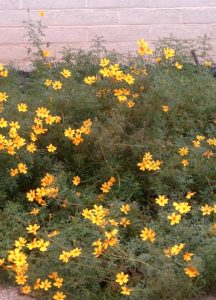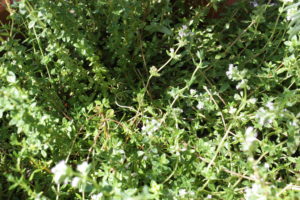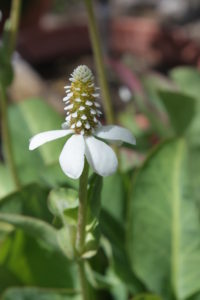Zika virus is the latest mosquito borne illness to garner worldwide headlines, but it is not the only one. Zika virus is transmitted by the bites of infected mosquitoes and so are many other deadly and debilitating diseases including West Nile virus, malaria, yellow fever, chikungunya and dengue fever.
There is no vaccine to prevent most of these diseases, thus the key to controlling these mosquito-borne diseases is to control mosquito populations. Mosquitoes lay their eggs in standing water, so both homeowners and commercial landscapers need to be vigilant in eliminating places where water can collect and stand in landscapes, yards and gardens.
But we can do more than that. Homeowners especially can plant landscape plants that can then be used as mosquito repellents. Note that these plants do not repel by merely sitting in the garden. The foliage must be bruised or crushed, releasing the oils and other repelling compounds inside the plant cells. Some homeowner education may be required.

Tagetes Palmerii
There are a vast array of plants that have the chemical compounds shown to deter mosquitoes, most of them highly fragrant and often with citrus-like scents. A number of these do well in the low-water landscape. The phytochemicals most involved in deterring mosquitoes include: carvacrol, citronellol, eucalyptol, nerol, geraniol, and thymol.
For charming landscape perennials that repel mosquitoes consider the hyssops, catmints and perennial marigolds.
Hyssops are found throughout the Southwestern mountains and they offer hummingbird attracting flowers in a variety of colors. Species include anise hyssop (Agastache foeniculum), giant hyssop or hummingbird mint (A. cana), Arizona hyssop (A. brevifolia), Mexican hyssop (A. mexicana), and Sonoran giant hyssop (A. wrightii).
Catmint (Nepeta mussinii) is less attractive to cats than catnip, thus homeowners will not have their garden visited by hordes of felines. Also called catmint, Nepeta X faassenii is cultivated for its attractive aromatic foliage and masses of blue flowers. It is used a groundcover, border edging, in containers and in rock gardens. It is drought tolerant, is generally deer resistant, and comes in a number of colorful cultivars in varying heights.
The marigold genus has a bad rap as unpleasant smelling, and I agree, the annuals can be odoriferous. The perennials tend to have more pleasing scents with notes of anise and citrus notes.
Especially nice is the tarragon substitute, sweet marigold, also called Mexican mint marigold (Tagetes lucida). Sonoran native Mt. Lemmon marigold (T. lemmoni) and Chihuahuan native Palmer’s marigold (T. palmeri) are both quite good at repelling mosquitoes. Plant the Palmer’s in USDA zone 9 to 7B gardens, the Mt Lemmon marigold in zone 8 to 7A gardens.
Shrubby aloysias have their place in the landscape. The genus is perhaps best known for the tropical lemon verbena (Aloysia citrodora), but includes a number of fragrant desert native shrubs. Commonly found in our region are Wright’s bee bush, also called mintbush lippia (A. wrightii), whitebush (A. gratissima), Rio Grande beebrush (A. macrostachya), and Sonoran whitebush (A. sonorensis).
Two cousins of aloysia are currently being planted as turf alternatives. Lippia (Lippia graveolens) and frogfruit (Phyla nodiflora). Studies indicate both are effective in deterring mosquitoes. Just imagine – repelling mosquitoes by simply playing on the lawn!

Thyme
Another turf substitute for some areas is thyme, and if you read the chemical list you may have noted “thymol.” Originally extracted from thyme, the chemical is a fragrant way to deter a number of insect pests, not just mosquitoes. Lemon thyme (Thymus X citriodorus) is an especially good deterrent.
Although not natives, I should mention two ornamental grasses, citronella grass (Cymbopogon nardus), and lemon grass (C. citratus). Both excellent at repelling mosquitoes, and good in a xeriscape – but cold tender.

Yerba Mansa
I am currently doing some work with two Southwest native perennials, slender poreleaf (Porophyllum gracile) and yerba mansa (Anemopsis californica). Both species contain some of the same mosquito repelling chemicals found in the other plants mentioned here, the question is how well do they repel? (I will have to get back to you on that.) California native yerba mansa is an excellent pond plant, requiring very little care. On the opposite end of the spectrum, slender poreleaf requires little water and does best in well drained soil. It requires rejuvenation pruning every three years to look its best.
Dr. Jacqueline A. Soule’s latest book is due out this summer, “Month by Month Gardening in Arizona, Nevada, and New Mexico” (Cool Springs Press). Jacqueline currently lives, teaches and writes in Tucson, AZ, where she also serves as chair of the Advisory Board of the Desert Legume Program. She will be a speaker at Desert Green XX, October 20-21 at Texas Station in North Las Vegas, NV. For more information, visit www.desert-green.org.
